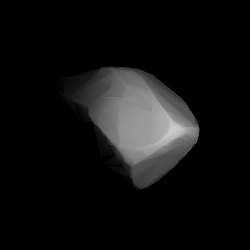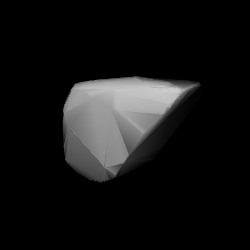Related Research Articles
2578 Saint-Exupéry, provisional designation 1975 VW3, is an Eoan asteroid from the outer region of the asteroid belt, approximately 17 kilometers in diameter. It was discovered by Russian astronomer Tamara Smirnova at the Crimean Astrophysical Observatory in Nauchnyj on 2 November 1975, and named after French aviator and writer Antoine de Saint-Exupéry.
2072 Kosmodemyanskaya, provisional designation 1973 QE2, is a stony asteroid from the inner regions of the asteroid belt, approximately 6 kilometers in diameter.

2002 Euler is a stony background asteroid from the inner regions of the asteroid belt, approximately 17 kilometers (11 miles) in diameter. It was discovered on 29 August 1973, by Russian astronomer Tamara Smirnova at the Crimean Astrophysical Observatory in Nauchnyj, and assigned the prov. designation 1973 QQ1. It was named after Swiss mathematician Leonhard Euler.
3409 Abramov, provisional designation 1977 RE6, is a stony Koronian asteroid from the outer region of the asteroid belt, approximately 11 kilometers in diameter. It was discovered on 9 September 1977, by Soviet–Russian astronomer Nikolai Chernykh at Crimean Astrophysical Observatory in Nauchnyj on the Crimean peninsula. The asteroid was named after Russian writer Fyodor Abramov.
3067 Akhmatova, provisional designation 1982 TE2, is a stony Flora asteroid from the inner regions of the asteroid belt, approximately 6 kilometers in diameter.
14335 Alexosipov, provisional designation 1981 RR3, is a stony Flora asteroid from the inner regions of the asteroid belt, approximately 4 kilometers in diameter. It was discovered by Soviet–Russian astronomer Nikolai Chernykh at the Crimean Astrophysical Observatory in Nauchnyj, on 3 September 1981. The asteroid was named after astronomer Alexandr Osipov.
58097 Alimov, provisional designation 1976 UQ1, is a background asteroid and relatively slow rotator from the central region of the asteroid belt, approximately 4 kilometers in diameter.

1957 Angara is a stony Eos asteroid from the outer regions of the asteroid belt, approximately 18 kilometers in diameter. It was discovered on 1 April 1970, by Soviet astronomer Lyudmila Chernykh at the Crimean Astrophysical Observatory in Nauchnyj, and named after the Siberian Angara River.
2010 Chebyshev, provisional designation 1969 TL4, is a rare-type carbonaceous asteroid from the outer regions of the asteroid belt, approximately 25 kilometers in diameter. The asteroid was discovered on 13 October 1969, by Soviet astronomer Bella Burnasheva at the Crimean Astrophysical Observatory in Nauchnyj, on the Crimean peninsula. It was named for mathematician Pafnuty Chebyshev.
2126 Gerasimovich, provisional designation 1970 QZ, is a stony background asteroid from the inner regions of the asteroid belt, approximately 8 kilometers in diameter. It was discovered on 30 August 1970, by Soviet astronomer Tamara Smirnova at the Crimean Astrophysical Observatory in Nauchnyj, on the Crimean peninsula. The asteroid was named after Russian astronomer Boris Gerasimovich.
2140 Kemerovo, provisional designation 1970 PE, is a dark asteroid from the outer region of the asteroid belt, approximately 30 kilometers in diameter.
3963 Paradzhanov, provisional designation 1969 TP2, is a Nysian asteroid from the inner regions of the asteroid belt, approximately 6 kilometers in diameter. It was discovered on 8 October 1969, by astronomer Lyudmila Chernykh at the Crimean Astrophysical Observatory in Nauchnyj, on the Crimean peninsula. The asteroid was named after Soviet film director Sergei Parajanov (Sargis Paradzhanov) in 1996.
1857 Parchomenko, provisional designation 1971 QS1, is a stony asteroid and suspected binary from the inner regions of the asteroid belt, approximately 8 kilometers in diameter.
2122 Pyatiletka, provisional designation 1971 XB, is a stony asteroid from the inner regions of the asteroid belt, approximately 11 kilometers in diameter.
1907 Rudneva, provisional designation 1972 RC2, is a stony background asteroid from the central regions of the asteroid belt, approximately 11 kilometers in diameter. It was discovered on 11 September 1972, by astronomer Nikolai Chernykh at the Crimean Astrophysical Observatory, Nauchnyj, on the Crimean peninsula. The asteroid was named after Soviet geodesist and war hero Yevgeniya Rudneva.

1854 Skvortsov (prov. designation: 1968 UE1) is a stony background asteroid and relatively slow rotator from the middle region of the asteroid belt, approximately 9 kilometers in diameter. It was discovered on 22 October 1968, by Russian astronomer Tamara Smirnova at the Crimean Astrophysical Observatory in Nauchnyj on the Crimean peninsula. It is named after astronomer Evgenii Skvortsov.
3345 Tarkovskij, provisional designation 1982 YC1, is a carbonaceous background asteroid from the inner regions of the asteroid belt, approximately 22 kilometers (14 miles) in diameter. It was discovered on 23 December 1982, by Russian astronomer Lyudmila Karachkina at the Crimean Astrophysical Observatory in Nauchnyj, on the Crimean peninsula, and named after film-director Andrei Tarkovsky. The C-type asteroid is a slow rotator with a rotation period of 187 hours.

2120 Tyumenia is a dark background asteroid, approximately 45 kilometers in diameter, located in the outer regions of the asteroid belt. It was discovered on 9 September 1967, by Soviet astronomer Tamara Smirnova at the Crimean Astrophysical Observatory in Nauchnyj, on the Crimean peninsula. The asteroid was named for the now Russian district of Tyumen Oblast in Western Siberia.
2011 Veteraniya, provisional designation 1970 QB1, is a stony Vestian asteroid from the inner regions of the asteroid belt, approximately 6 kilometers in diameter. It was discovered on 30 August 1970, by Russian astronomer Tamara Smirnova at the Crimean Astrophysical Observatory, Nauchnyj, on the Crimean peninsula, and named for the Soviet veterans of the Second World War.
1790 Volkov, provisional designation 1967 ER, is a stony Florian asteroid from the inner regions of the asteroid belt, approximately 8 kilometers in diameter.
References
- 1 2 3 4 5 6 "13474 V'yus (1973 QO1)". Minor Planet Center. Retrieved 16 January 2019.
- 1 2 Schmadel, Lutz D. (2007). "(13474) V'yus". Dictionary of Minor Planet Names – (13474) V'yus. Springer Berlin Heidelberg. p. 800. doi:10.1007/978-3-540-29925-7_8828. ISBN 978-3-540-00238-3.
- 1 2 3 4 "JPL Small-Body Database Browser: 13474 V'yus (1973 QO1)" (2018-04-20 last obs.). Jet Propulsion Laboratory . Retrieved 16 January 2019.
- 1 2 3 4 5 "LCDB Data for (13474) V'yus". Asteroid Lightcurve Database (LCDB). Retrieved 19 October 2017.
- 1 2 3 4 5 "Asteroid 13474 V'yus". Small Bodies Data Ferret. Retrieved 16 January 2019.
- 1 2 "Asteroid (13474) V'yus – Proper elements". AstDyS-2, Asteroids – Dynamic Site. Retrieved 16 January 2019.
- 1 2 3 Masiero, Joseph R.; Mainzer, A. K.; Grav, T.; Bauer, J. M.; Cutri, R. M.; Dailey, J.; et al. (November 2011). "Main Belt Asteroids with WISE/NEOWISE. I. Preliminary Albedos and Diameters". The Astrophysical Journal. 741 (2): 20. arXiv: 1109.4096 . Bibcode:2011ApJ...741...68M. doi:10.1088/0004-637X/741/2/68 . Retrieved 19 October 2017.
- 1 2 3 4 Mainzer, A.; Grav, T.; Masiero, J.; Hand, E.; Bauer, J.; Tholen, D.; et al. (November 2011). "NEOWISE Studies of Spectrophotometrically Classified Asteroids: Preliminary Results". The Astrophysical Journal. 741 (2): 25. arXiv: 1109.6407 . Bibcode:2011ApJ...741...90M. doi:10.1088/0004-637X/741/2/90.
- 1 2 Clark, Maurice (October 2008). "Asteroid Lightcurve Observations". The Minor Planet Bulletin. 35 (4): 152–154. Bibcode:2008MPBu...35..152C. ISSN 1052-8091 . Retrieved 19 October 2017.
- ↑ "MPC/MPO/MPS Archive". Minor Planet Center. Retrieved 19 October 2017.